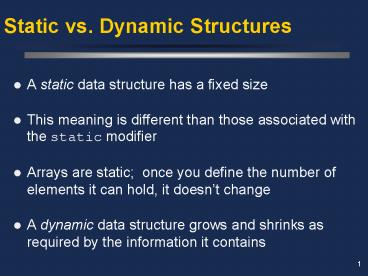Static vs' Dynamic Structures - PowerPoint PPT Presentation
1 / 17
Title:
Static vs' Dynamic Structures
Description:
rear. list. 12. Queues ... Analogy: a line of people at a bank teller's window. enqueue. dequeue. 13. Queues ... enqueue - add an item to the rear of the queue ... – PowerPoint PPT presentation
Number of Views:393
Avg rating:3.0/5.0
Title: Static vs' Dynamic Structures
1
Static vs. Dynamic Structures
- A static data structure has a fixed size
- This meaning is different than those associated
with the static modifier - Arrays are static once you define the number of
elements it can hold, it doesnt change - A dynamic data structure grows and shrinks as
required by the information it contains
2
Object References
- Recall that an object reference is a variable
that stores the address of an object - A reference can also be called a pointer (?)
- They are often depicted graphically
3
References as Links
- Object references can be used to create links
between objects - Suppose a Student class contained a reference to
another Student object
4
References as Links
- References can be used to create a variety of
linked structures, such as a linked list
5
Abstract Data Types
- An abstract data type (ADT) is an organized
collection of data and a set of operations used
to manage that data - The set of operations define the interface to the
ADT - As long as the ADT accurately fulfills the
promises of the interface, it doesn't really
matter how the ADT is implemented - Objects are a perfect programming mechanism to
create ADTs because their internal details are
encapsulated
6
Abstraction
- Our data structures should be abstractions
- That is, they should hide details as appropriate
- We want to separate the interface of the
structure from its underlying implementation - This helps manage complexity and makes the
structures more useful
7
Intermediate Nodes
- The objects being stored should not have to deal
with the details of the data structure in which
they may be stored - We can use a separate node class that holds a
reference to the stored object and a link to the
next node in the list - Therefore the internal representation actually
becomes a linked list of nodes
8
Class Node
- class Node
- Object data
- Node next
- public Node (Object tobj, Node tnext)
- data tobj
- next tnext
9
Class LinkedList
- public abstract class LinkedList
- private Node head // front of the list
- private Node previous // before current node
- private Node current
- public Linkedlist ()
- head null
- previous null
- current null
- public abstract boolean isEmpty()
- public abstract void insert (Object tobj) //
before current - public abstract remove() // remove
current node
10
Other Dynamic Lists
- It may be convenient to implement a list as a
doubly linked list, with next and previous
references
11
Other Dynamic Lists
- It may also be convenient to use a separate
header node, with references to both the front
and rear of the list
12
Queues
- A queue is similar to a list but adds items only
to the end of the list and removes them from the
front - It is called a FIFO data structure First-In,
First-Out - Analogy a line of people at a bank tellers
window
13
Queues
- We can define the operations on a queue as
follows - enqueue - add an item to the rear of the queue
- dequeue - remove an item from the front of the
queue - empty - returns true if the queue is empty
- As with our linked list example, by storing
generic Object references, any object can be
stored in the queue - Queues are often helpful in simulations and any
processing in which items get backed up
14
Stacks
- A stack ADT is also linear, like a list or queue
- Items are added and removed from only one end of
a stack - It is therefore LIFO Last-In, First-Out
- Analogy a stack of plates
15
Stacks
- Stacks are often drawn vertically
16
Stack Operations
- Some stack operations
- push - add an item to the top of the stack
- pop - remove an item from the top of the stack
- peek - retrieves the top item without removing it
- empty - returns true if the stack is empty
- The java.util package contains a Stack class,
which is implemented using a Vector
17
Collection Classes
- The Java 2 platform contains a Collections API
- This group of classes represent various data
structures used to store and manage objects - Their underlying implementation is implied in the
class names, such as ArrayList and LinkedList - Several interfaces are used to define operations
on the collections, such as List, Set, SortedSet,
Map, and SortedMap






























